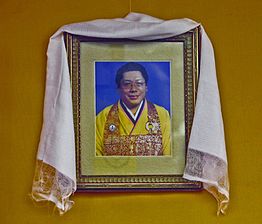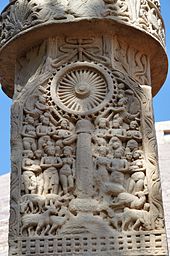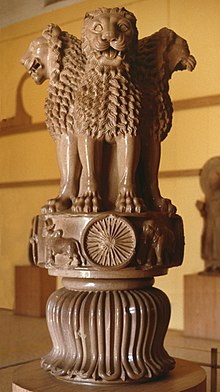The relationship between Christianity and politics is a historically complex subject and a frequent source of disagreement throughout the history of Christianity, as well as in modern politics between the Christian right and Christian left. There have been a wide variety of ways in which thinkers have conceived of the relationship between Christianity and politics, with many arguing that Christianity directly supports a particular political ideology or philosophy. Along these lines, various thinkers have argued for Christian communism, Christian socialism, Christian anarchism, Christian libertarianism, or Christian democracy. Others believe that Christians should have little interest or participation in politics or government.
Foundations
The Hebrew Bible contains a complex chronicle of the Kings of Israel and Judah, written over the course of many generations by authors whose relationships and intimacy with the rulers of the several kingdoms fluctuated widely in both intimacy and respect. Some historical passages of the Hebrew Bible contain intimate portrayals of the inner workings of the royal households of Saul, David and Solomon. The accounts of subsequent monarchs are frequently more distanced and less detailed and frequently begin with the judgment that the monarch "did evil in the sight of the Lord".
The Christian New Testament instead begins with the story of Jesus, crucified as a criminal who had offended both the Jewish priesthood and the Roman imperial authorities. At least to outward appearances, Jesus was at the periphery of political life and power in the Roman province of Judea.
Early Christians were described by Celsus as those who refused military service and would not accept public office, nor assume any responsibility for the governing of cities. Origen confirms this description and adds that Christians do more for the good of the empire by forming an "army of piety" that prays for the well-being of the emperor and the safety of the empire. It has been argued that Christianity made a significant positive contribution to the development of modern democracy.
Right-wing
The Christian right within evangelical Christianity has formed many of its political views on social issues such as abortion, homosexuality and public education from passages in both the Old Testament and the New Testament.
Romans 13
In the Epistle to the Romans, chapter 13:1-7, Paul instructs Roman Christians to submit to government. See also 1 Peter 2:13-17 and Titus 3:1 for parallels. Mainstream theologians and the Christian right have interpreted Romans 13:1–7 to mean Christians should support the state and wield the sword when necessary, as God has instituted the idea of governments to be his main tool to preserve social order.
Left-wing
The first Jewish Christian communities, as described in the Acts of the Apostles, were organized along a principle of communal ownership of goods. The Christian left have interpreted these and other passages to mean that an ideal society would be based on Christian socialism or Christian communism.
There are other intentional christian communities that, inspired by the first christian church as described in Acts 2 and 4, share all their possessions in an effort to put into action Christ's command to love God and neighbour. The Simple Way, the Bruderhof communities, and the Hutterites are all inspired, to some degree, by the model of church community described in Acts.
Libertarianism
An emerging tradition of political thought, Christian libertarians maintain that state intervention to promote piety or generosity can be unethical and counterproductive. Coercion by threat of violence robs otherwise moral acts of their virtue, inspires resentment and disrespect even for just laws on the part of the coerced, and has a spiritually deleterious effect upon the coercers. As John Chrysostom, late 4th-century Church Father and Archbishop of Constantinople, writes in his work On the Priesthood (Book II, Section 3),
For Christians above all men are not permitted forcibly to correct the failings of those who sin. Secular judges indeed, when they have captured malefactors under the law, show their authority to be great, and prevent them even against their will from following their own devices: but in our case the wrong-doer must be made better, not by force, but by persuasion. For neither has authority of this kind for the restraint of sinners been given us by law, nor, if it had been given, should we have any field for the exercise of our power, inasmuch as God rewards those who abstain from evil by their own choice, not of necessity. Consequently much skill is required that our patients may be induced to submit willingly to the treatment prescribed by the physicians, and not only this, but that they may be grateful also for the cure. For if any one when he is bound becomes restive (which it is in his power to be), he makes the mischief worse; and if he should pay no heed to the words which cut like steel, he inflicts another wound by means of this contempt, and the intention to heal only becomes the occasion of a worse disorder. For it is not possible for any one to cure a man by compulsion against his will.
While Christian libertarians disagree over whether and to what extent agents of the state possess the moral authority to intervene in the lives of citizens, government involvement is generally viewed with skepticism and suspicion. As with the Christian left, war and nation-building are common targets of ethical scrutiny from Christians espousing the libertarian philosophy.
The governing maxim for many natural-rights libertarians, including those of faith, is the non-aggression principle, which forbids the initiation of force but does not preclude the restrained, proportional use of defensive or disciplinary violence against the initiator. It has been compared to the Golden Rule and its converse, the Silver Rule. Christian libertarians often defend the institution of private property by pointing to the many Biblical injunctions against theft, to the voluntary nature of faith and the sharing of goods in early Christian communities, and to the fact that Jesus never advocated the redistribution of income and wealth by political means.
According to Christian libertarianism, to seize the life, liberty, or legitimately acquired property of an individual by coercion, even for that person's well-being or for the benefit of others, constitutes a violation of his or her human dignity as an image-bearer of God. Thus, most forms of taxation and all laws that prevent or distort free and nonviolent exchange are unacceptable. The classical doctrine of original or ancestral sin furthermore suggests to Christian libertarians that political (and for some left-libertarians, economic) power ought to be democratically distributed and decentralized to guard against government oppression and the natural human tendency to corruption. In opposition to centralized political authority, Christian libertarians frequently cite the eighth chapter of the Biblical book of 1 Samuel (1 Kings LXX), in which God tells the prophet Samuel that the children of Israel have rejected Him by demanding a king to reign over them, and He describes the many ways such a king will oppress the people.
While one of the Church's societal roles may be to promote righteousness in service and humble obedience to God, equal liberty is the highest or only political value. The state's raison d'être is to prevent rights violations, to quarantine or punish justly, and ideally to restore offenders so they can again peaceably dwell and participate in civil society.
Anarchism
Not only does the action of Governments not deter men from crimes; on the contrary, it increases crime by always disturbing and lowering the moral standard of society. Nor can this be otherwise, since always and everywhere a Government, by its very nature, must put in the place of the highest, eternal, religious law (not written in books but in the hearts of men, and binding on every one) its own unjust, man-made laws, the object of which is neither justice nor the common good of all but various considerations of home and foreign expediency.
Sermon on the Mount
More than any other Bible source, the Sermon on the Mount is used as the basis for Christian anarchism. The foundation of Christian anarchism is a rejection of violence, with Leo Tolstoy's The Kingdom of God Is Within You regarded as a key text. Tolstoy takes the viewpoint that all governments who wage war, and churches who in turn support those governments, are an affront to the Christian principles of nonviolence and nonresistance.
Christians have interpreted Romans 13:1–7 to mean they should support the state and wield the sword when requested, as God has sanctified the state to be his main tool to preserve social order. Christian anarchists do not share this interpretation of Romans 13 but given Paul's declaration to submit to authorities they do not attempt to overthrow the state. However anarchists still describe the state as an evil power executing wrath and vengeance. As wrath and vengeance are opposite to the Christian values of returning good for evil, Christian anarchists neither support, nor participate in, the state.
Book of Revelation
Christian eschatology and various Christian anarchists, such as Jacques Ellul, have identified the State and political power as the Beast in the Book of Revelation.
Apocalyptic texts frequently coach radical criticism of existing regimes under the form of allegory; this, at least, is a frequently mentioned interpretation of the Book of Daniel, frequently interpreted by secular scholars as a second-century diatribe against Antiochus IV Epiphanes, who persecuted the Jews and provoked the revolt of the Maccabees. The Book of Revelation contains even more vehement imagery, which many secular scholars believe was directed against the Roman empire. The empire, or the city of Rome itself, are identified by these scholars as the Whore of Babylon, and the Roman emperor becomes the Beast or Antichrist. Both divine punishment and economic and military catastrophe are prophesied against "Babylon", which most scholars agree is John's code name for Rome.
No call to arms is contained within the Christian apocalypse. Instead, the calamities that doom the oppressive regime represented by these allegorical figures are expected from divine intervention alone. Nevertheless, if the books are properly read in this way, they seem to evidence deep hostility to the Roman government, no doubt a reaction to the persecution of Christians by the Roman state.
Anabaptism
Anabaptism adheres to a two kingdom concept. This is the belief that the kingdom of heaven or of Christ (the Church) is different and distinct from the kingdoms of this world. It essentially means the separation of church and state but differs from Protestantism in their belief that the church has no right to interfere in the affairs of the state any more than the state in the church. This viewpoint is still held by the most religiously conservative Anabaptism groups, such as the Amish, Old Order Mennonites, Conservative Mennonites, and Old Order River Brethren.
Not all Anabaptist churches subscribe to anarchist ideologies. The Hutterite church traces its roots back to the Radical Reformation and Jacoub Hutter, but respect and adhere to government authority. The Bruderhof, another church community in the Anabaptist tradition, respects the god-given authority of the state, while acknowledging that their ultimate allegiance is to God.
The Christian empire
When the Roman persecution of Christianity came to an end under Constantine I with the Edict of Milan, and the Nicene Christian faith became the favoured religion of the Roman Empire, Christians were presented with issues they never before had to confront. Could a Christian ruler legitimately wage war? If Christians were discouraged in Scripture from entering litigation against one another, how were they supposed to function as officers within a judicial system? What civil rights were to be afforded to non-Christians or to heterodox Christians in a civil commonwealth governed by the orthodox faithful?
Augustine of Hippo was one religious figure who confronted these issues in The City of God; in this work, he sought to defend Christians against pagan charges that the abandonment of official sponsorship of pagan worship had brought civil and military calamities upon the Roman Empire by the abandoned pagan deities. (Pecknold, 2010) Augustine sought to reaffirm that the City of God was a heavenly and spiritual matter, as opposed to an earthly and political affair. The City of God is contrasted with, and in conflict with, the city of men; but the City of God's eventual triumph is assured by divine prophecy.
Catholics, war and peace
Catholics historically have had a wide variety of positions on issues of war and peace. The historical peace churches are now the chief exponents of Christian pacifism, but this was an issue that first came to light during the Roman Empire.
Soldiers in the Roman military who converted to Roman Catholicism were among the first who had to face these issues. Catholics in the Roman military had to confront a number of issues, that go beyond the obvious one about whether war could be reconciled with the Christian religion. Paganism saturated Roman military institutions. Idols of the Greco-Roman gods appeared on the legionary standards. Military service involved oaths of loyalty that maight contradict Catholic teachings even if they did not invoke pagan gods. The duties of Roman military personnel included law enforcement as well as defense, and as such Roman soldiers were sometimes obliged to participate in the persecution of Christians themselves. Sexual licentiousness was considered to be a moral hazard to which military personnel were exposed. See Imperial cult (ancient Rome).
The conversion of Constantine I transformed the relationship of the Christian churches with the Roman military even as it transformed the relationship of the churches with the Roman state. A strongly contrary idea, sometimes called "caesaropapism", identified the now Catholic Empire with the Church militant. The Latin word Christianitas originally meant the body of all Christians conceived as a political body, or the territory of the globe occupied by Christians, something akin to the English word Christendom. Apocalyptic texts were reinterpreted. The idea of a Christian empire continued to play a powerful role in Western Europe even after the collapse of Roman rule there; the name of the Holy Roman Empire bears witness to its claims to sanctity as well as to universal rule. An apocryphal apocalypse of Pseudo-Methodius, written during the seventh century, depicts a saintly Last Roman Emperor who holds his earthly kingdom in anticipation of Christ's return. According to Pseudo-Methodius, the Last Emperor will wage war in the last days against God's enemies, including Gog and Magog and the Antichrist.
Early Middle Ages
The Western Roman Empire faded out of existence in the late 5th century; Charlemagne arguably revived it in the form of the Holy Roman Empire from 800. Both popes and emperors recognized that church and state worked together de facto in ruling medieval Europe. Secular rulers would support missionary efforts in order to enlarge their realms. Bishops and abbots were not only church leaders, but often also large land-owning princes and thus vassals of secular feudal lords. The line dividing church and state interests was not always clear.
In Western Europe, after the collapse of Roman rule, yet more issues arose. Sensing war as an aspect of politics, the Catholic Church expressed periodic unease with the fact that, in the absence of central imperial rule, Christian princes made war against each other. Church councils attempted to limit the volume and permitted times of warfare from 989 onwards by proclaiming the Truce of God, which sought to set limits upon the times and places where warfare could be conducted, and to protect Christian non-combatants from the hazards of war.
The Crusades involved - at least in theory - a declaration of war by the entire armed body of Christendom against an enemy that was implicitly labelled an enemy of God and His Church. Some Crusades aimed to recover and secure Jerusalem and the Holy Land from the Muslims (1095-1291); other Crusades attacked the Cathari (1209-1229), and the Teutonic Knights and their supporters fought against non-Catholics (including Eastern Orthodox Christians) in the Baltic Sea area (1147-1410). In Spain, the Crusader mindset continued for several centuries after the last crusade in the Middle East, in the form of the Reconquista, a series of wars (711-1492) fought to recover the Iberian peninsula from the Muslim Moors. These latter wars were local affairs, and the participation of the entire armed body of Catholics - let alone Orthodox Christianity - was only theoretical.










